A Beginner's Guide To French Wine
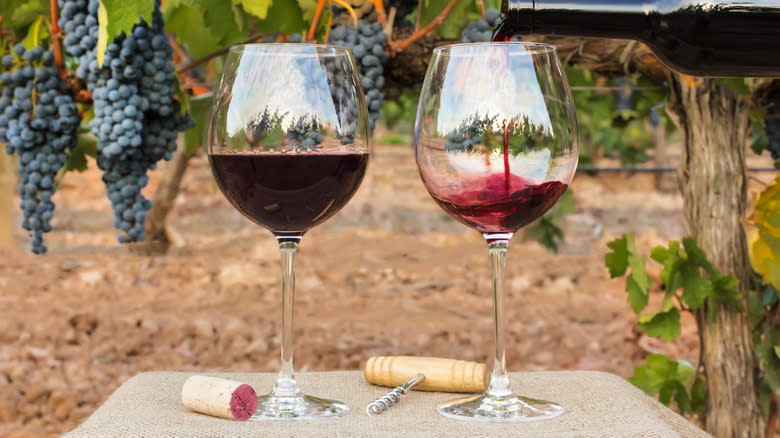
French wine is often deemed the best in the world. This widely held opinion has developed, in part, due to France's unique geology and geography as Meninger's International recorded wine writer Andrew Jefford explaining: "It is the only major wine-producing nation on earth which covers both propitious cool-climate, high-latitude zones and warmer-climate, mid-latitude zones [...] There is no land mass which has the positional advantages of France."
For centuries, French vintners have taken advantage of their country's unique characteristics to produce an array of world class reds, whites, rosés, and sparkling wines. These wines have bewitched generations of oenophiles but, to the average consumer, French wine often appears more intimidating than enticing. Due to its reputation, French wine is perceived as being incredibly sophisticated and many people fear that a failure to understand or enjoy it reflects their own lack of refinement.
While many people fret about French wine, it, just like any other wine, is made to be enjoyed. With that in mind, and with the use of wine experts and expert sources, we have put together a beginner's guide to this, the most prestigious of wine countries. This article won't make you an expert, but it will give you the information you need to sit back, relax, and simply enjoy the wine in front of you.
Read more: The Ultimate Vodka Brands, Ranked
France Is The Birthplace Of Many Globe-Trotting Grape Varieties
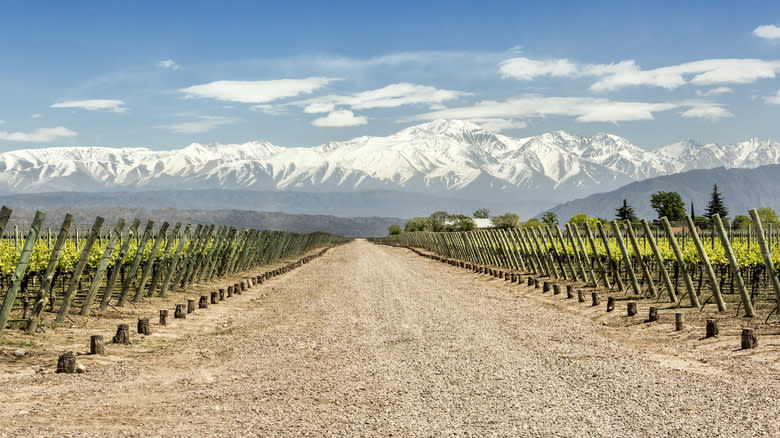
France is the world's benchmark when it comes to wine. This is largely due to the global proliferation of French grapevines. From North America to Australia, French varieties like syrah, cabernet sauvignon, and malbec are widely planted and used to produce a huge array of wines. More often than not, these vary enormously from the wines made with the same grape varieties back in France.
Initially, the widespread adoption of French grape varieties was a result of colonialism. Europeans who invaded and settled in other continents, including North America, introduced vines from Europe in an attempt to recreate the wines they were so fond of. During the centuries that followed, the desire to replicate French wines abroad only grew with Thomas Jefferson in particular striving to achieve this goal. Due to these early efforts, many of these French grape varieties have gone on to define wine production in the so-called New World.
Malbec is a prime example of how French grape varieties have been successfully adopted elsewhere. After being introduced to Argentina in 1868, malbec flourished thanks to sunny and dry conditions as well as the beneficial effects of altitude. As a result of these prime conditions, the country is now home to 70% of all global malbec vines.
Wines Are Labeled By Region And Not Grape Variety
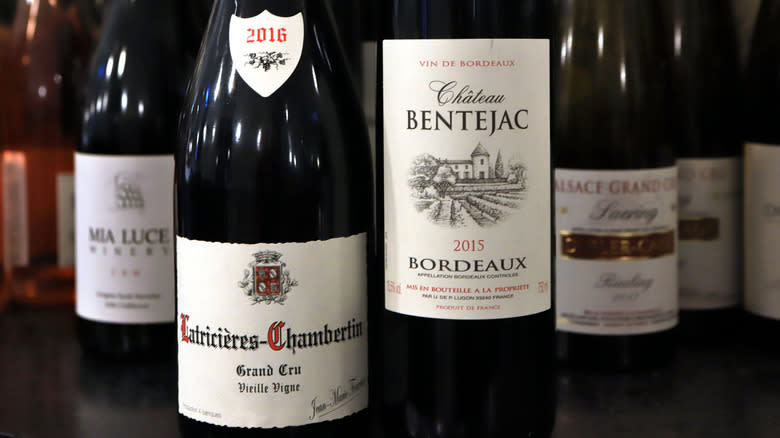
Unlike the United States and some other wine-producing countries, in France, the grape variety is often not printed on the label. Instead, nearly all French wines simply state where the wine was produced. The reason for this is simple: French producers believe that where the wine is produced, and not the grape variety, has a greater influence on the finished product's characteristics.
The environmental conditions in which grapes are grown is known as terroir. Terroir changes drastically across France and even within a single wine region. For example, conditions for one vintner in Burgundy can be radically different from those of a vintner a few miles away. What's more, different French villages have adopted unique production processes that also greatly influence the finished wine. Labeling wines after their location and not grape variety allows buyers to take these differences into account when selecting a bottle if they have the requisite knowledge.
For those that don't have an in-depth knowledge of France's numerous appellations -- which is most consumers -- the use of place names instead of grape varieties is both frustrating and intimidating. Often, these individuals have no means of discerning what the wine will be like other than by opening the bottle and trying some.
There Are Several Terms Unique To French Wine
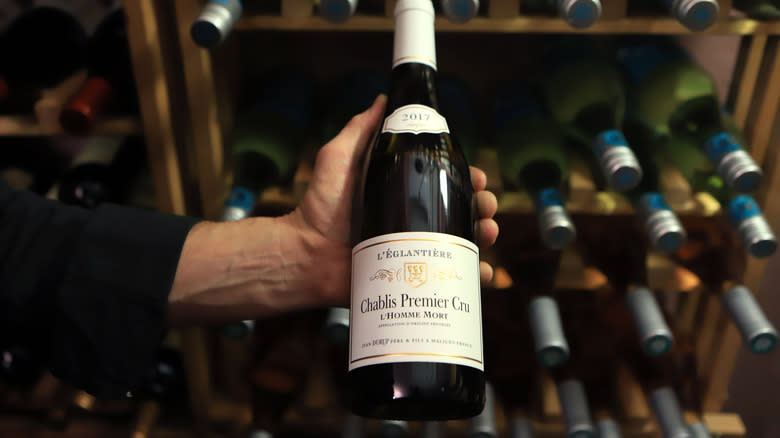
The French wine industry's obsession with terroir has resulted in several wine classifications being created. These are indicated via specialist terms on each bottle. Perhaps the most important of these terms is AOC which stands for Appellation d'Origine Contrôlée. To be labeled as an AOC wine, products must adhere to a strict set of rules for their particular production area. This involves anything from time of harvest to what grape varieties can be used.
Within the AOC classification, there are further designations. These indicate what region, sub-region, and sometimes even village the wine comes from. Wines produced from exceptional vineyards are often labeled 'premier cru,' while 'grand cru,' indicates that the grapes were harvested from the appellation's best vineyards.
Wine that doesn't qualify for AOC classification can apply to be classified as Indication Géographique Protégée which is denoted as IGP. These wines are still made under strict regulations that control where the grapes are sourced and how the wine is produced. However, more varieties of grapes are often allowed to be used and the geographical area in which the wine can be made is larger. This gives wineries more opportunities to be inventive.
The lowest classification for French wines is Vin de France. This classification only guarantees one thing: that the wine was produced in France. Often, these wines are made from grapes from across the country and therefore lack a distinct sense of terroir.
Bordeaux Is France's Most Famous Wine Region

As France's most famous wine region, Bordeaux can claim to be one of the most renowned wine-producing regions in the world. Bordeaux is best known for its red wines. These are made from a blend of up to six grapes including cabernet sauvignon, merlot and cabernet franc. Blended red wines make up around 90% of the region's entire production. Despite coming from the same region, red wines produced in Bordeaux do vary as is reflected by the region's 57 appellations and 61 grand cru classes.
The region is split in half by the Gironde estuary. Wines produced on the left bank generally contain a greater proportion of cabernet sauvignon and demonstrate a powerful, highly tannic profile. Wines produced on the right bank have a greater proportion of merlot making the wine more suited to drinking young. The most prestigious sub-region on the left bank is Médoc, while Saint-Emilion is a renowned sub-region on the right bank.
Although Bordeaux's wine industry is dominated by red wine, high-quality white wine is still produced in the area. The most prestigious of these is Sauternes, a sweet dessert wine that's made by allowing the grapes to become infected with a fungus known as Botrytis cinerea. Otherwise known as noble rot, this fungus dehydrates the grapes, concentrating their flavors and sugars. The end result is a sweet, yet slightly acidic wine that contains the flavors of apricots and honey.
Burgundy Is Not Far Behind

Dissimilarly to Bordeaux, the majority of wine produced in Burgundy is white. These white wines are nearly always exclusively made from chardonnay. Known as white Burgundy, this wine is produced in four sub-regions, the most prestigious of which is Côte de Beaune. White Burgundy produced in Côte de Beaune is richly and complexly flavored thanks to an aging process that takes place in oak barrels.
White wine might make up the majority of Burgundy's production, but the region's most eminent wines are red. Again, these are made with only one variety of grape, in this case, Pinot Noir. Red Burgundy -- or simply, Burgundy -- is beloved by oenophiles the world over for its incredible ability to express terroir.
One of the main reasons why Burgundy expresses terroir so well is that soil composition varies drastically across the region. For example, an abundance of clay in Pommard creates a powerful Burgundy that tastes much different to Burgundy from Pouilly-Fuissé where soils are rich in limestone. Aside from its stark portrayal of terroir, Burgundy is known for its hugely aromatic bouquet, light color, and acidity.
While Bordeaux is dominated by large wineries, the vast majority of wine produced in Burgundy comes from small plots due to inheritance laws that were passed in the 1800s. This, when combined with the difficulty in producing these wines, often results in Burgundy being prohibitively expensive.
Natural Wine Got Its Start In Rural France
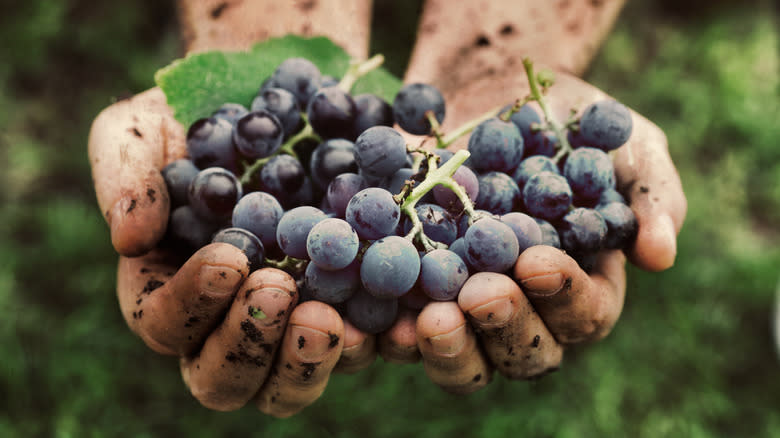
France's wine industry is built upon centuries of tradition, but this does not mean that the industry is stagnant or resistant to change. In fact, French winemakers were at the forefront of the biggest wine trend of recent times, natural wine.
Natural wine is a subgroup of the industry that uses minimal intervention throughout growing, harvesting, and processing as explained to Club Oenologique by sommelier Charles Carron Brown: "Natural wine is a form of viticulture and winemaking where there is minimal manipulation, both in the vineyard and within the winemaking practices. It's more of a concept than a rigidly defined term."
While natural wine was the de facto offering before the mechanization of farming, these traditional processes were brought back to the fore by a group of French vintners in Beaujolais during the 1960s. Slowly, excitement around these wines began to grow. They tasted remarkably different to the wines of the time, packed with expression and energy. Before too long, natural wine began to trend with vintners across the world adopting old-fashioned practices. Those who had remained dedicated to them all along were quickly catapulted towards the top of the proverbial pyramid. The global natural wine trend shows no sign of abating, especially as consumers grow in their appreciation of products that are made in socially and environmentally sustainable ways.
The Country Is Famous For Champagne
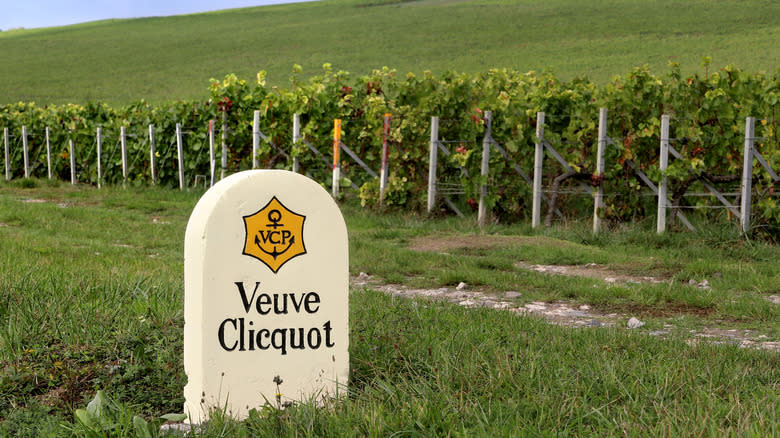
Champagne is the one wine that even those disinterested in the industry have heard of. This is thanks to the beverage's long and illustrious history. Since the 5th century, it has been associated with French royalty. In the centuries since, its connections with luxury only grew as was highlighted to Harper's Bazaar by the director of the United Kingdom's Champagne Bureau Francoise Peretti: "Its reputation continued to spread throughout the 19th century – a time of prosperity and celebration when no high-society event was complete without it. Wherever people partied, they partied with champagne."
To be called Champagne, the wine must be produced in Champagne, a region just east of Paris. The wine is usually made from three different grape varieties: chardonnay, Pinot Noir, and Pinot Meunier. While initially fermented separately, the wines from these grapes are mixed together along with some reserved wines to create a blend. This blended wine is then placed inside bottles alongside a mixture of yeast, yeast nutrients, and sugar, which causes the wine to undergo secondary fermentation.
The only time reserve wine is not used in the production of Champagne is when a vintage wine is being produced. This Champagne is composed solely of wine produced in a single year. Single-vintage Champagne is generally deemed more prestigious than blended Champagne and is subsequently more expensive.
Wines From Beaujolais Are Gaining Notoriety

As a wine region, Beaujolais was previously known for its production of Beaujolais nouveau, a bright wine that was designed to be drunk only a few weeks after the grapes were harvested. Unfortunately, the success of these wines led to a catastrophic drop in quality as Anne McHale, a master of wine, explained to the BBC: "It was a huge success based on marketing. But it declined in the 1990s when too many producers jumped on the bandwagon and the quality declined, getting weaker and more acidic."
In the intervening decades, vintners have revitalized the region by producing carefully constructed wines that, despite being complex, have not lost the bright, cheerful side that initially made them famous. As in the past, the vast majority of these wines are made with the gamay grape.
Many people believe that the best Beaujolais wines come from the region's ten crus. Among the most impressive is Brouilly, a cru that produces fruity, bold wines that prove a perfect accompaniment to the traditional, rich dishes served in French brasseries. Thanks to innovative wine producers working in this cru and others, Beaujolais is often cited as the most exciting wine region in the entirety of France. What's more, many of these producers continue to build on the tradition of natural wine, a trend that started here during the 1960s.
Muscadet Is One Of France's Best White Wines

Muscadet is an often overlooked white wine that's produced in the western reaches of the Loire Valley. The wine is made exclusively from melon de Bourgogne, a grape that does not carry many noticeable characteristics aside from high acidity levels and an ability to endure cool temperatures. When grown in the Loire Valley, however, melon de Bourgogne becomes the perfect vehicle for expressing local terroir. The resulting wine is highly acidic, mineral-driven, and not at all fruity. These characteristics make Muscadet the perfect white wine for pairing with seafood.
In terms of production, muscadet is aged on the lees. This means that the wine is aged while still mixed with dead yeast particles. Eventually, the yeast breaks down adding complexity to the wine. Despite this process, and the hard work of producers, muscadet still has a reputation as a basic, cheap wine.
One of the ways producers have fought against this poor reputation is by petitioning for nine crus to be established in the area. While several of these have already been made official, not everyone is ready to let go of Muscadet's poor image. This was highlighted by winemaker Thierry Martin in an interview with Meninger's International: "The problem today is that people know Muscadet but not in a good way. Even wine producers have a tendency to disassociate the crus with Muscadet [...] it is difficult to place our wines among the greats."
Many French Grape Varieties Are Overlooked
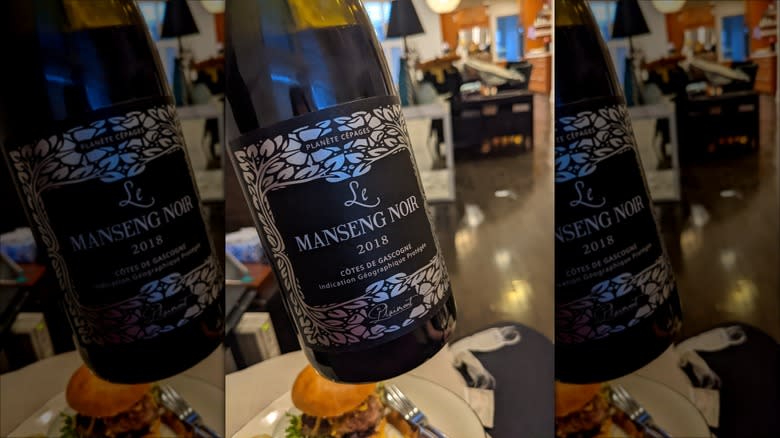
Melon de Bourgogne is not the only grape in France to be overlooked. In fact, there are many varieties that are used only sparingly, if at all. Mauzac, a grape grown in Languedoc, is a prime example of this. While an enticing grape that boasts flavors of green apple, Mauzac is almost exclusively used to produce blanquette de Limoux, France's original sparkling wine.
Other French grapes do not have a heritage product to ensure their continued survival and it is only thanks to the work of dedicated conservationists that they have not disappeared altogether. The Plaimont Cooperative, a collection of 800 growers, has saved a multitude of overlooked grapes including tardif and manseng noir. Both of these grapes are now being used to produce wine and manseng noir is even being touted as a possible replacement for the climate-vulnerable tannat.
As is often the case, regional grape varieties and the wines made from them are also overlooked. Hailing from the area around Toulouse, négrette is dismissed by the rest of the nation which is a shame given that the red wines it produces are full of character; young négrette bears a striking resemblance to Beaujolais. The grape can also be used to produce age-worthy wines that demonstrate great intensity.
Provençe Is Known For Producing Fantastic Rosé
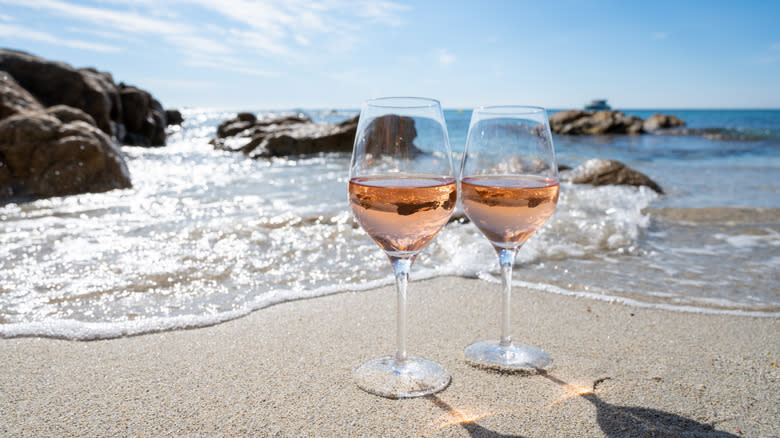
Rosés from Provençe have been one of France's most successful wines during the 21st century. Huge demand has not only meant that more wine is being produced in this area than ever before but that the wine itself is worth more. In 2009, a hectoliter of rosé from Provençe cost an average of €134. By 2020, this value had doubled. A great deal of this increased value comes from rosé's image which, thanks to endorsements from many celebrities, brings to mind luxurious summers spent in France's south.
Provençe has a romanticized reputation, but it is undeniable that the warm, sunny region is perfectly suited to producing rosé. Although characteristics vary between sub-regions, these warm, dry conditions typically result in a pale wine packed with aromas of berries. Instead of being cloyingly sweet, Provençal rosé is crisp with an inherent minerality, making it incredibly refreshing.
The wine's characteristics make Provençal rosé incredibly versatile and therefore marketable as was highlighted to Wine Spectator by Philippe Schaus CEO of Moët Hennessy: "Provence is increasingly becoming to rosé wines what Champagne is to sparkling wines. These wines have found their place not only in the apéritif consumption moment, but also in fine dining and high energy bars and clubs."
Climate Change Is Affecting The Production Of French Wine

French winemakers and their products are directly influenced by the weather. As climate change continues to alter weather throughout all four seasons, many producers are seeing their products change before their eyes. For those vintners lucky enough to own plots in Bordeaux, the current changes are actually proving beneficial with hotter summers and cool, wet winters resulting in wine that tastes much richer. However, like all vintners, those in Bordeaux face many risks associated with climate change as climate scientist Andrew Wood explained to National Geographic: "France is being hit with wildfires, which affects other Mediterranean wine regions like California and Australia, and smoke is really bad for wine. You can actually taste the smoke in grapes."
Access to water is becoming an increasing issue for French vineyards as is the vines' tendency to produce smaller, sweeter, and more alcoholic grapes during hotter summers. While many vintners are using a variety of means to combat these challenges, others have decided to invest in different grape varieties that are more suited to the new conditions. Unfortunately, these new varieties often go against the strict guidelines stipulated by many appellations.
It is undeniable that some grapes and wines will not be able to endure the climate crisis. Many point to French merlot as the first grape that will fail. But as some falter, others will thrive. Ultimately, it's down to the winemakers to do the best with the options they've got.
Languedoc Is The Largest Wine-Producing Region In France
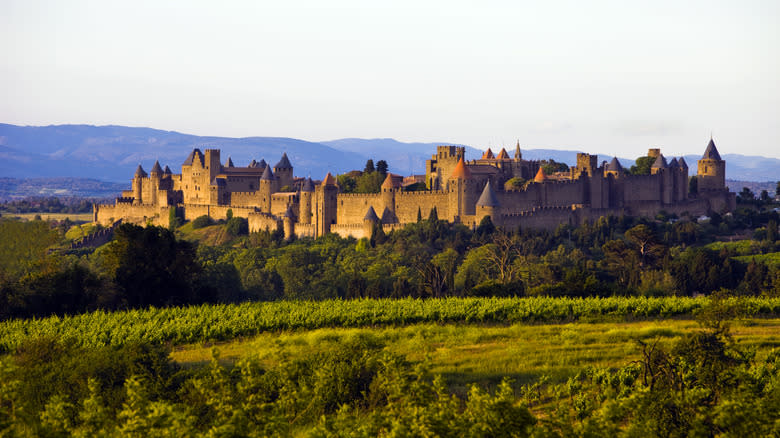
Languedoc, or Languedoc-Roussillon as it is formally known, produces the most wine of any French region. The quantities are massive; Languedoc's annual wine production has been estimated at 1.36 billion liters. That's more wine than Australia produces in a year.
Such huge production sees a vast array of wines being produced. This can prove overwhelming for the regular person. To best make sense of the region, it is easiest to split the wines of Languedoc into two groups: Appellation Contrôlée wines and IGP Pays d'Oc.
As is the case across France, Languedoc's Appellation Contrôlée wines are produced under strict guidelines. These include where in Languedoc the vineyards are located, which grape varieties are used, and how the wine tastes. While several of these wines are excellent, many enthusiasts are more excited about Languedoc's IGP Pays d'Oc.
Pays d'Oc wines allow for 58 different grape varieties to be used along with a huge geographical growing area. As winemaker Bruno Le Breton explained to Decanter: "With the IGP, as a producer, we have the ability to work freely with the best methods and techniques, and can easily adapt to new situations." What's more a great deal of IGP Pays d'Oc are being produced with organic and low-intervention methods. The result is a buzzing, highly innovative wine industry in the area. This excitement is clear whenever you drink Languedoc's IGP Pays d'Oc wine.
Red Wine Consumption Is Dropping In France

Although red wine might be a product that is almost synonymous with France, the country's consumption of red wine has plummeted in recent decades. In 1995, about 8 million hectoliters of red wine were sold in France. By 2020, that number had halved.
There are many reasons why red wine consumption is falling in France, including the public's interest in sobriety and a rise in the consumption of rosé. As winemaker, Thomas Montagne summarized to The Guardian: "In the 1990s we had the 'French paradox', where studies showed that red wine was good for your health. Now people, especially the young, are turning to rosé wines, which are easier to drink, contain fewer tannins and feel more festive."
This fall in demand is affecting wineries across the country. The French government has even started an uproot program that pays farmers €6,000 per hectare of vineyard they rip up in an effort to decrease the country's production totals. These grants are being accepted by vintners across the country including hundreds of those working in France's most prestigious wine regions like Bordeaux.
In the interim, huge amounts of excess wine is being destroyed to maintain the product's value. The French government has committed €200 million to the project, supplemented by €160 million from the European Union. Alcohol from the destroyed wine is being sold for use in products like hand sanitizer; an ignominious end for some of the world's finest wine.
Read the original article on Daily Meal.

